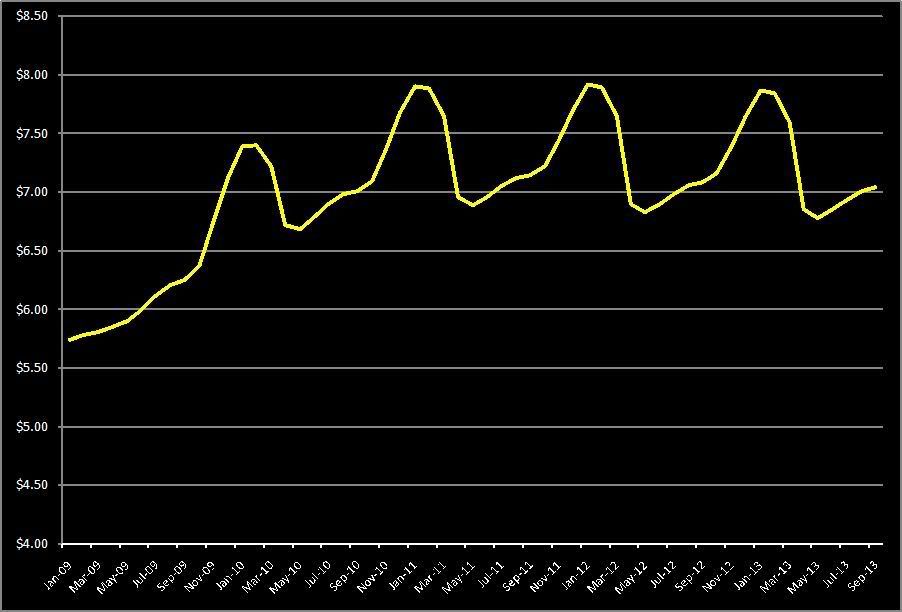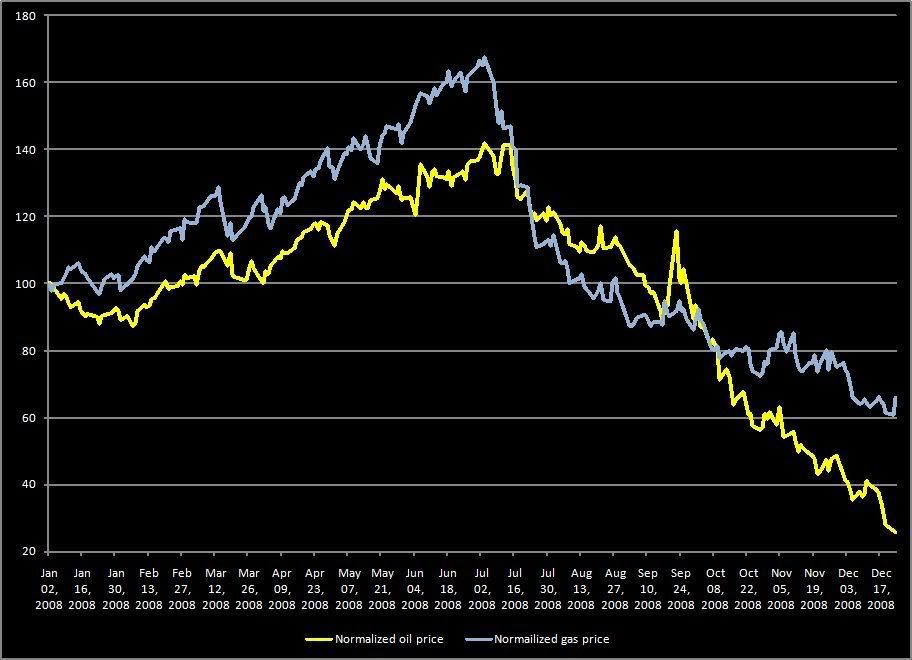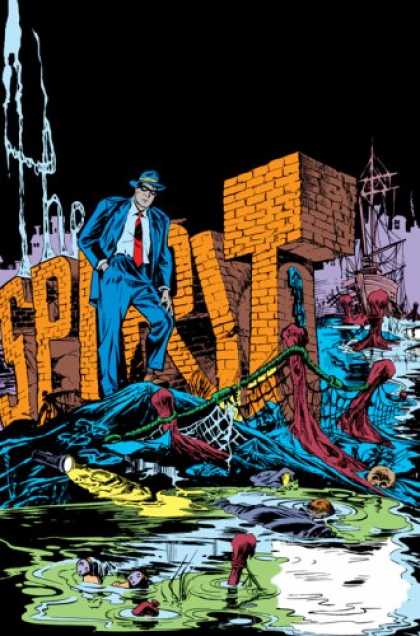Not the best comics published in 2008, period, but the best ones I read and wrote little reviews for on
Facebook (using the Visual Bookshelf application). I undoubtedly skipped a few worthy ones--ones I read but didn't write about, and ones I never bothered to read. You will notice most of them are reprints, which reflects the fact that I am an old fuddy-duddy. I didn't bother to check if all these books were actually
published in 2008, because I am a lazy old fuddy-duddy. I hope you will enjoy this break from politics, economics and finance.
Readers patient enough to read all the way through will notice how many
Drawn & Quarterly books I have read and reviewed. This publisher is definitely the best publisher in English at the moment, and that in part reflects the tastes of creative director Tom Devlin. He was the publisher of
Highwater Books, and is certainly one of the best modern editors of comics, if not
the best. (Too bad he came along right when the entire publishing industry has started to keel over dead...)
I purchased these books either through the publishers, from Powells.com, or from local Houston shops like
Bedrock City (owned by fellow Memorial High School class of '81 grad, Richard Evans), Nan's Comics & Games,
Domy, and the
Brazos Bookstore.
 Nat Turner
Nat Turner by Kyle Baker. Quite unlike most of Baker's other, lighter work. He willingly steps into a straitjacket to tell this story--there is almost no dialogue, and what text there is is the apocalyptic confession of Nat Turner. Baker let's his pictures do the talking. He doesn't flinch from Turner's murderousness, including the killing of children. Nor does he simplify the slave trade--one of the first scenes is of Africans capturing other Africans to sell to white slavers. He shows what slaves will do to escape--literal escape, of course (Turner's father ran away) but also suicide and infanticide. And the humanity-crushing brutality of slavery is shown over and over. The point, I think, is to demonstrate that if you have a system as evil as slavery, you will necessarily toss up a few Nat Turners along the way. Turner may have been an outlier, but he was a still a logical product of the depraved and evil system which held him captive from the moment he was conceived.
 Against Pain
Against Pain by Ron Rege. An astonishing collection. I didn't realize how necessary this book was until I read it. Ron Rege's comics have appeared in various publications (some with huge circulations, some very small) for many years now, and this collection brings together 20 (!) years' worth of work. It includes the classic "High School Analogy"* (the story of Peter Parker's alienation in high school that Steve Ditko only hinted at), "Boys," his staggering collaboration with Joan Reidy about high school sexuality as seen from a girl's point of view, and the emotional "Fuc 1997" from Kramer's Ergot (as well as many other excellent comics). The package and production are beautiful as well.
*Originally published in the classic Coober Skeber Marvel Benefit Issue, a collection marred only by the inclusion of a lame Dr. Strange story. Nocturnal Conspiracies
Nocturnal Conspiracies by David B. It's been said that other people's dreams are as boring as one's own are interesting. David B.'s dreams seem like they would be interesting to experience, but are less interesting to read. This is a book to read for David B.'s artwork and intriguing storytelling. But the stories here are not as interesting as, say, his intriguing historical stories that have run in
Mome.
 The Freak Brothers Omnibus
The Freak Brothers Omnibus by Gilbert Shelton, Dave Sheridan, and Paul Mavrides. The Freak Brothers have been around since 1967. This collection is by far the most complete published, so if you wanted to have just one volume of Freak Brothers comix in your library, this would be the one to have. However, you might be a bit disappointed--the printing is not the greatest. Some of the B&W artwork is muddy (a shame, because Shelton and his collaborators sometimes pull out the stops with their linework), and the color sections rather pale. If you can see past the production weaknesses, though, this is a collection of some truly wonderful comics.
 Glacial Period
Glacial Period by Nicholas de Crecy. Published with the participation of the Louvre, this is the first example (that I know of) of De Crecy's work in English. (American readers might recognize his work, though--he did the backgrounds in
The Triplets of Belleville.) It's a slight work, but entertaining. Future archeologists, accompanied by talking dogs genetically engineered to have extremely good senses of smell (their olfactory senses now include carbon dating), are seeking a lost city under a glacier that has covered Europe. One of the dogs, named Hulk in honor of an ancient deity, finds the perfectly preserved remains of the Louvre. His human companions also find it separately, and coming from a post-visual society, they are at a loss at how to interpret the images. But Hulk is actually able to communicate directly with the artworks, who want noting more than to escape their icy tomb. De Crecy's shaky line and beautiful watercolor are on display here, but perhaps so as not to overshadow the artworks depicted, he doesn't push the colors as much as he did in
Leon La Came. The art is nonetheless lovely. I hope
Glacial Period sparks enough interest in De Crecy's work that someone will consider translating
Leon La Came into English.
 Classic Screwball Strips: Happy Hooligan
Classic Screwball Strips: Happy Hooligan by Frederick Burr Opper. We are really living in the golden age of classic comic strip reprints. The general practice has been to reprint every strip, in order, from start to finish. Such an approach would be unbelievably tedious for some strips, so I am grateful that in NBM's
Happy Hooligan, they take the position that a well-selected collection is enough.Frederick Opper was a great cartoonist (his work as a political cartoonist for
Puck was already legendary when he made the transition to comic strips), and
Happy Hooligan, dating from just after the turn of the century, is an important, well-made strip that really codified many of the storytelling devices that would come to typify comics (like the exclusive use of word balloons and abandonment of captions). But the strips are all the same--Happy Hooligan, a good-natured bum, tries to do a good deed, causes mayhem, and is beaten and arrested. The occasional strips where this sequence
doesn't happen really stand out. The production values here are pretty good (though perhaps not as good as IDW or Fantagraphics).
Happy Hooligan is an important addition to the growing library of comic strip reprints.
 Explainers
Explainers by Jules Feiffer. This brick of a book is amazingly dense. Feiffer's strips were long and wordy (compared to his daily paper counterparts), wry more than funny, quite ironic and clever. He surprisingly goes after liberals as much as conservatives (there has always been a self-criticizing strain of liberalism). His drawing is "minimal" but not in the same way as, say, Charles Schulz. And the minimalism is deceptive, because he is a really good artist--his hand-writerly style manages to convey movement and body-language exquisitely. Where he fails here is when his characters are "over-acting" in their postures. Perhaps Feiffer is taking a cue from contemporary theater productions that would put actors up on bare stages. Like those modernist productions, everything comes down to the characters. It was a radical approach, but similar to
Peanuts in its total dependence on its "actors."
 Blue Pills
Blue Pills by Frederik Peeters. Peeters art is excellent. He belongs to that inky school that includes such artists as Blutch. The subject matter is autobiographical--his relationship with a woman (and her infant son) who are both HIV positive. There is a lot of anxiety about sex, well-handled by Peeters. The couple panic after a condom breaks, and rush to see their doctor. After some questions and a blood test, he tells Peeters that the chances of him getting HIV from this were the same as seeing a white rhinoceros on the way home. This is where comics can do something better than almost any other medium--it can bring a metaphor to life without seeming extravagant. Peeters keeps imagining a white rhino following, which is depicted visually.
 Jamilti and Other Stories
Jamilti and Other Stories by Rutu Modan. Excellent, ironic stories and terrific art from the breakout star of Actus Tragicus. This is some of her earlier work (there is quite a bit more, actually, especially collaborations with Etgar Keret). Well worth reading.
 Moomin
Moomin vol. 3 by Tove Jansson. Whimsical and gentle. The kind of comic strip to read while listening to Belle and Sebastian.
 Breakdowns: Portrait of the Artist as a Young %@&*!
Breakdowns: Portrait of the Artist as a Young %@&*! by Art Spiegelman. This takes the original
Breakdowns, and adds a well-done autobiographical strip that was originally published in the
Virginia Quarterly and an afterward. The additions give it kind of a self-obsessed feeling, which has been kind of a weakness of Spiegelman's for a while. I'd like him to bury the self in the other, the way great novelists and filmmakers and even a few cartoonists do regularly. Still, it's a great read over-all, and it's wonderful to see
Breakdowns back in print.
 Love & Rockets: New Stories #1
Love & Rockets: New Stories #1 by Jaime and Gilbert Hernandez. Great as usual. Apparently they are doing book collections instead of the comic book. Jaime's story turns several of his characters into oddball superheroes, and Gilbert engages in some of the odd short stories he does so well when he leaves his Palomar cast aside.
 Burma Chronicles
Burma Chronicles by Guy Deslisle. He's no George Orwell, but he has a knack for ending up in Asian dictatorships and offering his average-guy observations of them. Humorous, personal, and occasionally alarming.
 Alan's War
Alan's War by Emmanuel Guibert. Pretty good. The first 2/3rds are an American's memory of World War II (training in the U.S. and shipping out to Europe). His war is closer to
Catch 22 (but gentler) than any heroic "greatest generation" story. The art is fantastic and unique. Emmanuel Guibert's textures and tones recall Alberto Breccia, but his art comes out of a clean Franco-Belgian tradition. It may have been better to end the story with the end of the war rather than cram Alan's post-war life into the back of the book, but since his story is so involved with that of Gerhart and Vera Muench, it would have been a shame to cut off that story right when it was starting, at the end of the war.
Alan's War is an interesting, occasionally beautiful book.
 The Complete Terry & the Pirates vol. 4
The Complete Terry & the Pirates vol. 4 by Milton Caniff. Caniff does a great deal to mature Terry in this volume. He suspected war was coming and wanted Terry to be a creditable soldier when it happened. He has to make Terry go from boy to man with a series of solo adventures, including the great Raven Sherman storyline.
 Journey vol. 1
Journey vol. 1 by William Messner-Loebs. Absolutely wonderful--a classic alternative comic from the 80s reprinted. Set during the time of Tucemseh on the frontier, it's much more than a backwoods adventure. Extremely rich characters. It is marred only with some ill-considered "cross-overs" with other alt-comics of the day, which just don't fit at all.
 Curses
Curses by Kevin Huizenga. Huizenga works in a classical early 20th century comics style--his drawing recalls Mutt and Jeff and Barney Google. Like those strips, he is able to casually combine the just-realistic-enough with the "cartoony." And as Chester Brown did in Louis Riel, he invests this old slapstick approach with a kind of modern seriousness. Sometimes it works well, and even when it misses, the results are still worth reading.
 The Nancy Book
The Nancy Book by Joe Brainard. Really cool. Brainard is a mostly forgotten pop artist who was much more into comic and comic strips than most of his peers, who quoted them without ever really exploring their narrative possibilities. Perhaps it was that he was a poet as well that made him see comics for what they were. These Nancy works range from cute to clever to really dirty, and he plays expertly with pastiche and unexpected juxtaposition.
 American Flagg! vol. 1
American Flagg! vol. 1 by Howard Chaykin. Quite excellent when Chaykin was drawing it, but the fill in issues are a bit painful to look at. It's a period piece, to be sure, but an excellent and amusing one. Certainly the cleverest science fiction comic of its decade.
 Zot! The Complete Black-and-White Stories 1987-1991
Zot! The Complete Black-and-White Stories 1987-1991 by Scott McCloud. These stories are quite moving. No one is ever going to get too excited by Scott McCloud's artwork, but as YA stories, these comics seem really effective.
 B.P.R.D. volume 7: Garden of Souls
B.P.R.D. volume 7: Garden of Souls by John Arcudi, Guy Davis, and Mike Mignola. The appeal of the
Hellboy comics was Mike Mignola's excellent art. But I have to admit that Guy Davis's art (combined with Dave Stewart's coloring) is both excellent, unique, and utterly distinct from Mignola's.
 The Complete Little Orphan Annie vol. 1
The Complete Little Orphan Annie vol. 1 by Harold Grey. Another excellent addition to IDW's library of classic American comic strips. This publisher is doing important work in this field. Extremely clean reproductions for the most part. It's interesting to see how quickly Gray got the characters right--the evolution was very fast. "Daddy" has to be the most irresponsible parent in history.
 110 percent
110 percent by Tony Consiglio. A funny lil book from a great, underrated cartoonist. I wish we could see more of his work.
 Gary Panter
Gary Panter by Gary Panter. Staggering.
 The Complete Terry & The Pirates vol. 3
The Complete Terry & The Pirates vol. 3 by Milton Caniff. This volume is where Terry really starts to go from a series of improbable adventures to something deeper. Caniff starts to humanize his previously rather racist deprictions of Chinese, acknowledging their emotional lives and, more importantly, their feelings of patriotism in the face of the invading Japanese. Terry also becomes a more mature character whose presence no longer seems like that of a 3rd wheel, but vital. Great characters like Hu Shee, Raven Sherman, and Dude Hennick are introduced.
Labels: comics




























































